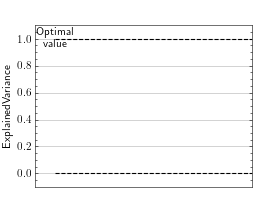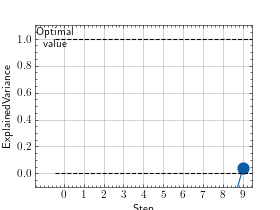Explained Variance¶
Module Interface¶
- class torchmetrics.ExplainedVariance(multioutput='uniform_average', **kwargs)[source]¶
Compute explained variance.
\[\text{ExplainedVariance} = 1 - \frac{\text{Var}(y - \hat{y})}{\text{Var}(y)}\]Where \(y\) is a tensor of target values, and \(\hat{y}\) is a tensor of predictions.
As input to
forwardandupdatethe metric accepts the following input:preds(Tensor): Predictions from model in float tensor with shape(N,)or(N, ...)(multioutput)target(Tensor): Ground truth values in long tensor with shape(N,)or(N, ...)(multioutput)
As output of
forwardandcomputethe metric returns the following output:explained_variance(Tensor): A tensor with the explained variance(s)
In the case of multioutput, as default the variances will be uniformly averaged over the additional dimensions. Please see argument
multioutputfor changing this behavior.- Parameters:
multioutput¶ (
Literal['raw_values','uniform_average','variance_weighted']) –Defines aggregation in the case of multiple output scores. Can be one of the following strings (default is
'uniform_average'.):'raw_values'returns full set of scores'uniform_average'scores are uniformly averaged'variance_weighted'scores are weighted by their individual variances
kwargs¶ (
Any) – Additional keyword arguments, see Advanced metric settings for more info.
- Raises:
ValueError – If
multioutputis not one of"raw_values","uniform_average"or"variance_weighted".
Example
>>> from torch import tensor >>> from torchmetrics.regression import ExplainedVariance >>> target = tensor([3, -0.5, 2, 7]) >>> preds = tensor([2.5, 0.0, 2, 8]) >>> explained_variance = ExplainedVariance() >>> explained_variance(preds, target) tensor(0.9572)
>>> target = tensor([[0.5, 1], [-1, 1], [7, -6]]) >>> preds = tensor([[0, 2], [-1, 2], [8, -5]]) >>> explained_variance = ExplainedVariance(multioutput='raw_values') >>> explained_variance(preds, target) tensor([0.9677, 1.0000])
- plot(val=None, ax=None)[source]¶
Plot a single or multiple values from the metric.
- Parameters:
val¶ (
Union[Tensor,Sequence[Tensor],None]) – Either a single result from calling metric.forward or metric.compute or a list of these results. If no value is provided, will automatically call metric.compute and plot that result.ax¶ (
Optional[Axes]) – An matplotlib axis object. If provided will add plot to that axis
- Return type:
- Returns:
Figure and Axes object
- Raises:
ModuleNotFoundError – If matplotlib is not installed
>>> from torch import randn >>> # Example plotting a single value >>> from torchmetrics.regression import ExplainedVariance >>> metric = ExplainedVariance() >>> metric.update(randn(10,), randn(10,)) >>> fig_, ax_ = metric.plot()

>>> from torch import randn >>> # Example plotting multiple values >>> from torchmetrics.regression import ExplainedVariance >>> metric = ExplainedVariance() >>> values = [] >>> for _ in range(10): ... values.append(metric(randn(10,), randn(10,))) >>> fig, ax = metric.plot(values)

Functional Interface¶
- torchmetrics.functional.explained_variance(preds, target, multioutput='uniform_average')[source]¶
Compute explained variance.
- Parameters:
multioutput¶ (
Literal['raw_values','uniform_average','variance_weighted']) –Defines aggregation in the case of multiple output scores. Can be one of the following strings):
'raw_values'returns full set of scores'uniform_average'scores are uniformly averaged'variance_weighted'scores are weighted by their individual variances
- Return type:
Example
>>> from torchmetrics.functional.regression import explained_variance >>> target = torch.tensor([3, -0.5, 2, 7]) >>> preds = torch.tensor([2.5, 0.0, 2, 8]) >>> explained_variance(preds, target) tensor(0.9572)
>>> target = torch.tensor([[0.5, 1], [-1, 1], [7, -6]]) >>> preds = torch.tensor([[0, 2], [-1, 2], [8, -5]]) >>> explained_variance(preds, target, multioutput='raw_values') tensor([0.9677, 1.0000])
